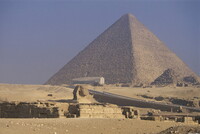Great Sphinx
unknown (Egyptian (ancient))

Download1A3-EG-G-2-A2_cp.jpg (413.4Kb)
Alternative Title
Great Sphinx at Giza
Date
-2520--2494Description
Context view, looking northwest, with the Pyramid of Khufu in the background and Khafre's Valley Temple in the foreground; The pyramid complex of Chephren, Cheops' son and successor (reigned ca. 2520-ca. 2494 BCE), measures 214.5 x 214.5 x 143.5 m and is partly enclosed by a natural limestone escarpment which was utilized for carving out some of the subsidiary burials of the royal family and courtiers. In addition to the usual components of pyramid, mortuary temple, causeway and valley temple, the complex included an innovative feature in the form of the Great Sphinx. This is a monumental sculpture (l. 80 m, h. 21 m) in the form of a human-headed lion wearing a royal headcloth. Constructed from a natural outcrop supplemented with limestone blocks, it lies north of the causeway of Chephren and adjacent to his valley temple. It was originally painted, and a secondary figure, of which almost no trace remains, seems to have been carved on the chest. Although the Sphinx formed an integral part of Chephren's pyramid complex, its exact significance is unknown. In front of it are the ruins of a small temple built of granite-faced limestone. During the decline of the necropolis in the Middle Kingdom (ca. 2008-ca. 1630 BCE) and Second Intermediate Period (ca. 1630-ca. 1540 BCE), the temple became engulfed by sand. Tuthmosis IV (reigned ca. 1400-ca. 1390 BCE) erected a red granite stele (in situ) recording his clearing of the temple and enclosed the area around the Sphinx with a wall into which stelae dedicated to various deities were set, among them some indicating that the Sphinx may have been a pilgrimage centre and oracular shrine. In the New Kingdom the Sphinx became associated with Harmachis, a manifestation of the sun-god, and with Hauron, a Canaanite deity worshipped in Egypt from the Second Intermediate Period. Over time, the Sphinx suffered considerable erosion and attempts were made to restore it in the Ptolemaic period (304-30 BCE). In the Roman period (30 BCE-395 CE) the temple was completely covered by sand, which also engulfed the figure itself until it was cleared by Giovanni Battista Caviglia in 1816. Source: Grove Art Online; http://www.groveart.com/ (accessed 1/15/2008)
Type of Work
monument; excavation (site)Subject
architectural exteriors, death or burial, deities, literary or legendary, rulers and leaders, Egypt--Civilization, Old Kingdom (Egyptian), Fourth Dynasty
Rights
Rights Statement
Licensed for educational and research use by the MIT community only